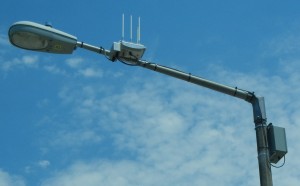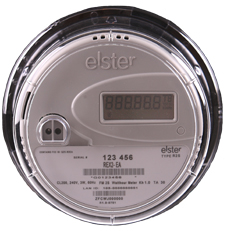 The entire electrical distribution system in the United States (and in many other countries) is being converted into something called the “Smart Grid.” The idea behind it is to distribute electricity more efficiently. When the “Grid” is fully constructed, electricity will be automatically sent where it is needed, when it is needed—even rerouted from one part of the country to another to satisfy instantaneous demand. Electric utilities will also have the ability to automatically turn off and on customer appliances like air conditioners and washing machines during times of greater or lesser demand for electricity.
The entire electrical distribution system in the United States (and in many other countries) is being converted into something called the “Smart Grid.” The idea behind it is to distribute electricity more efficiently. When the “Grid” is fully constructed, electricity will be automatically sent where it is needed, when it is needed—even rerouted from one part of the country to another to satisfy instantaneous demand. Electric utilities will also have the ability to automatically turn off and on customer appliances like air conditioners and washing machines during times of greater or lesser demand for electricity.
In order to accomplish this, everyone’s electric meter is being digitized and automated. Meter readers are being completely eliminated. New electric meters are being installed on every home and business that continuously record information about electricity usage and automatically broadcast that information back to the electric company every few seconds or minutes, day and night. This is being done in one of three ways: (1) with microwave antennas; (2) over the power lines themselves; or (3) via fiber optic cable.
None of these methods is safe.
Method 1: Microwave transmission
Microwave technology has been the only method used until fairly recently. This means the electric company removes the old analog electric meter from your home or business and replaces it with a digital “Smart Meter” containing two microwave antennas. Typically, one antenna broadcasts at 900 MHz and communicates with the utility company. The second antenna broadcasts at 2.4 GHz and communicates with secondary antennas within the home that many customers have allowed to be installed on individual appliances. The second antenna is there regardless of whether the secondary antennas have been installed.
The company also builds a new network of broadcast towers, also called “repeaters” or “access points,” in your neighborhood. The access points (often small antennas mounted on existing utility poles) receive the data packets from everyone’s Smart Meters and re-broadcast them back to the utility company. Typically, each access point also has two antennas—one to communicate with directly with all the meters in the neighborhood, and one that connects all the access points and the utility company to the Internet—effectively an area-wide WiFi network.
In most areas the new digital meters also function as a “mesh network,” which means the meters themselves are used as relays to receive data from other meters and re-broadcast it further down the line until it reaches the utility company. This means that the meters transmit much more frequently. In California PG&E has admitted that while each meter broadcasts actual usage data only 6 times a day, it actually emits a signal on average 10,000 times a day, and in some cases as often as 132 times per second! Most of these emissions are for communication with all of the other meters in the network.
PG&E has also admitted that a Smart Meter’s peak power is 2.5 Watts, which is ten times more powerful than a cell phone, and that it continuouly emits a small amount of radiation even when not broadcasting.
Three sources of microwave exposure
As a consumer you are exposed to radiation from three sources: the Smart Meter itself; the relay tower(s) in your neighborhood; and the electric wiring in your home. Because the Smart Meter is connected to your house wiring, its signal is not only broadcast out into space every few seconds or minutes, but is also conducted over the wiring and surrounds you in your home. This makes Smart Meters more dangerous than cell phones. Many people have contacted us who can no longer live in their own home since a Smart Meter was installed, although they had been users of cell phones and had previously had no awareness of the dangers of electromagnetic radiation.
Sometimes there is also a fourth source of radiation: the radio transmitters that many customers have allowed the electric company to install on various appliances to monitor and control their use.
Method 2: Transmission over power lines
Some companies, instead of using microwave radiation, are sending the data about electricity usage over the power lines themselves. This pollutes not only your house wiring, but the entire power grid, with radio frequency (RF) energy. It means that you are surrounded by RF radiation emanating from power lines wherever you go in your city or area.
Method 3: Fiber optic cable
The third method being used to transmit the data is by fiber optic cable. Theoretically, this has advantages: it does away with the microwave antennas, and it does not use the power grid itself as a vehicle for information. However, a Smart Meter is still on your house, continuously recording and storing information about electricity use, and transmitting that information in pulses day and night not only into the fiber optic cable, but into the electric wiring of your house, where it still surrounds you. This is a relatively new technology, but already we have heard from a few people who were unable to live in their homes as soon as the Smart Meter and the fiber optic cable were connected.
These low levels of radiation are dangerous
Some people have claimed that Smart Meters expose you to more radiation than cell phones and that they violate FCC exposure standards. In certain cases they may be right, especially if the meter on your house is relaying data from hundreds of other meters and is transmitting over a hundred times a second. However, Smart Meters cause harm even when they do not exceed the FCC’s exposure limits. We cannot emphasize too strongly that the FCC’s exposure limits have no validity. These limits protect only against gross heating by high levels of radiation. They do not protect against direct damage to the heart, nervous system and other organs that can occur at extremely low, non-thermal levels of radiation.
Regardless of their power levels, Smart Meters are not safe for anyone. Especially people who are already electrically sensitive should never have a Smart Meter installed on their home or business.
Unfortunately, the “Smart Grid” is federally mandated, and utility companies throughout the country (and the world) are not giving consumers a choice. This invasion of privacy and health is presently being fought before public utility commissions and in courts, most vigorously in California.

